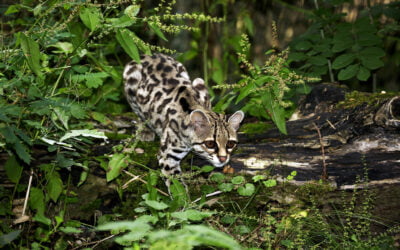Physical description of Geoffroy’s Cats
Where to start? Geoffry’s cat is a small spotted cat. About half a meter in length with larger males and smaller females, the Geoffroy’s cat is about the size of an average domestic cat. Tails are relatively long, about half the body length again, meaning that larger males can be over a meter in length with the tail included.
The fur is brown to grey with a much lighter underside, either beige or white. The spots are generally aligned on the back, running the length of the body. Spots are relatively large, up to two centimeters, meaning that there isn’t a lot of them in a row along the back. The face is striped, two stripes on the cheek, one of which goes through the eyes. All in the name of better camouflage.
Distribution and habitat of Geoffroy’s Cats
This South American cat, the Geoffroy’s Cat, lives in the very middle of the continent, through the pampas areas of Bolivia, Brazil and Paraguay, all the way into Uruguay and Argentina.
Ranging from tropical to subtropical, the cats mostly live in grasslands but are also known to inhabit drier scrub and forested areas. Wetland habitats are also home to Geoffroy’s cats, the most important thing being that the habitat offers a large amount of prey and vegetation cover while hunting.

Geoffroy’s Cat behaviour
Other than the well-known exception of the lion, most cats are solitary. This is also the case with Geoffroy’s cat. Males and females come together to reproduce but otherwise stay separate. Of course, mother cats spend a significant time with their kittens, teaching them to hunt.
Most of the time we see these cats at dusk and dawn, though they are quite nocturnal in their activity. During the day they are not seen very frequently. It is thought that during the day, they are generally inactive or resting in areas such as trees, heavy vegetation or other shelter. Areas that are more open and have more disturbance show some more activity during the day.
What do Geoffroy’s Cats eat?
Carnivorous and eating small mammals, mostly rodents and sometimes birds or amphibians! Sounds like a small cat to me. Geoffroy’s cat is no different. Depending on the habitat, the diet varies a little. In the deserts, small rodents are more common, whereas in the grass and ranchlands, cavies or mara are easier to hunt. In swamps and marshes, the ground/shore-nesting birds are easier to access, and so become part of the diet. The European hare is also a target species. Something that wasn’t part of the traditional diet until Europeans introduced it.
Like most cats, Geoffroy’s cat likes to ambush its prey.
Mating and Parental care of Geoffroy’s Cats
Cubs are born in litters of up to 4. They are somewhat similar in their development to domestic cats but are weaned a bit later at three months. However, kittens are not mature at this stage and stay longer with the mother to learn to hunt.

Who preys on Geoffroy’s Cats?
Domestic dogs are a significant killer of Geoffroy’s cat. As there is a significant overlap between their preferred habitat and that of cattle, and quite simply, farmers have dogs. In other habitats, the puma or jaguar and foxes will hunt the cat. Kittens are known to be at risk from some owls and eagles as well.
Impact of Geoffroy’s Cats on the human economy
The Geoffroy’s cat helps to keep down the cost of reversing terrible ecological decisions of the past. The introduction of the European Hare has displaced other grassland-dwelling rodents. The cat’s food preferences are such that it preys regularly on the hare, keeping the population down. Also, by doing so, it doesn’t overly rely on its original food sources and prevents itself from overeating animals that are struggling because of an invader (on top of habitat loss).
Previously Geoffroy’s cats were hunted for the value of their fur. However, this trade has been banned in all countries since the start of the 1990s.
Conservation status and human impact on Geoffroy’s Cats
As of writing, the IUCN status is least concern. Habitat loss is a threat, especially the fragmentation of suitable habitat by farming. As the cat has adapted well to ranchland, this threat could be less than for other species. The regional conservation status is, however, a bit different. In Bolivia and Argentina, the species is doing pretty well, but in Chile and Brazil, they are struggling a bit more.

Other important information about Geoffroy’s Cats
The genetic diversity is significant. It has a relatively large range and is known to create hybrids with the similar Oncilla in southern Brazil. Large genetic diversity is good for the well-being of the species, helping to minimize genetic weaknesses across the population and offering the best chance of being able to adapt to habitat change.
Geoffroy’s cats are close relatives to the ocelot (Leopardus pardalis) and kodkods (Leopardus guigna).










